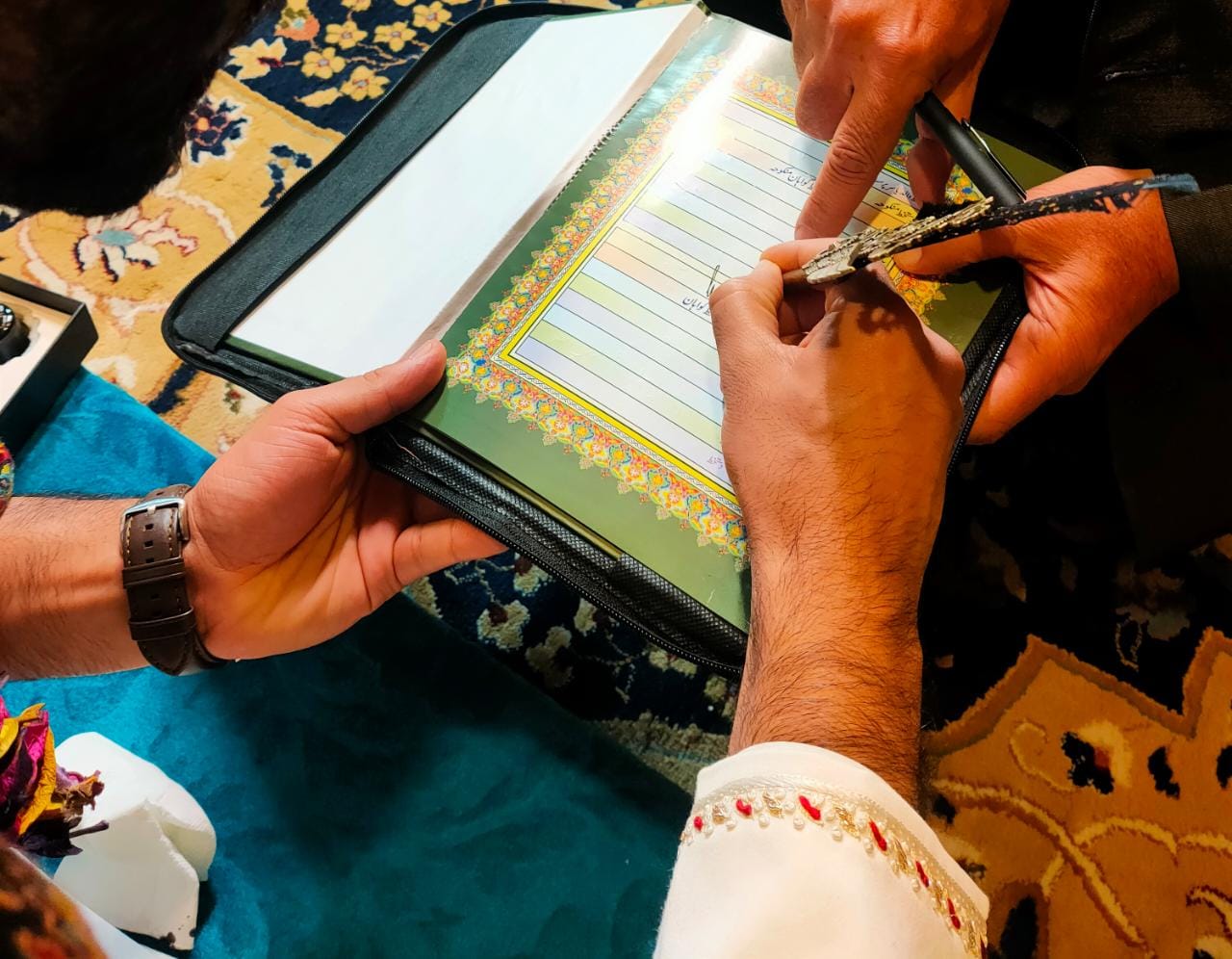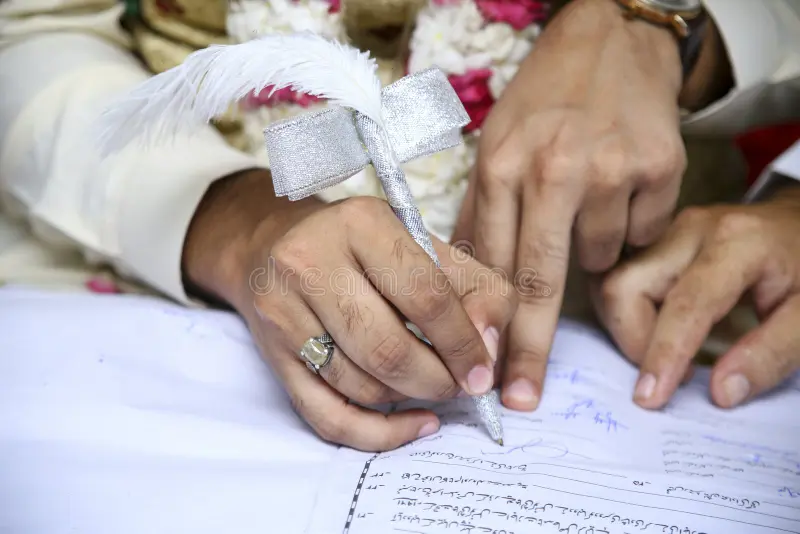Post-Marriage Customs in Kashmir: Emotional Displacement & Cultural Reform | Kashmir Weddings
By: Zulfikar Kashmiri | 08 September 2025
The Grand Celebration and The Quiet Aftermath: An Introduction to Kashmiri Matrimony
Proudly Married?
They call it tradition. But I call it a fracture dressed in silk. A ceremony of smiles, followed by a season of silence.
She’s married—on paper. But her feet never leave her father’s floor. Her husband? Left staring at a bed that echoes absence.
In Kashmir, we host the worst customs post-marriage. Not rituals— but emotional sabotage.
The bride’s parents play the devil’s role, pulling her back on this pretext or that. A cough. A cousin’s wedding. A festival. A mood.
And the son-in-law? He’s not a man. He’s a placeholder. A name on a certificate. A ghost in his own home.
If she’s meant to stay with you, why marry her off? Why the grand feast, the gold, the garlands— if the bond is just a badge?
Marriage isn’t a trophy. It’s a test. It’s not about being “proudly married.” It’s about being emotionally present.
So let’s ask the hard questions: Are we building homes, or just hosting ceremonies? Are we raising daughters to love, or to obey?
Because if this is culture, then culture needs a rewrite.
Post-Marriage Customs in Kashmir: Between Tradition and Emotional Displacement
The air in Srinagar is thick with the scent of kehwa and the vibrant melodies of wanwun. A Kashmiri wedding is not merely an event; it is a symphony of centuries-old traditions, a vibrant tapestry woven with threads of joy, community, and profound cultural significance. The pheran-clad guests, the elaborate Wazwan feast, the intricate rituals—every element is a testament to a rich heritage. Marriage in Kashmir is universally celebrated as a sacred milestone, a pivotal moment that solidifies family honor and projects an image of social stability and continuity.
Yet, behind the dazzling spectacle of the Lagan, behind the congratulatory handshakes and the joyful tears, often lies a quieter, more complex narrative—one that unfolds not in the public eye, but in the private, emotional recesses of a new marriage. This narrative is fraught with unspoken tensions and emotional contradictions that can, slowly and silently, fracture the very foundation a marriage is built upon. This article delves into one of the most pervasive yet least discussed of these contradictions: the tradition of extended post-marriage separation, where the bride remains with her parental home for prolonged periods, and the profound emotional displacement it can cause for the husband and the marital bond itself.
We will move beyond superficial explanations to explore the underlying dynamics of control, dependency, and insecurity. This is not an indictment of culture, but a call for its thoughtful evolution—a plea to balance cherished tradition with the urgent, human need for emotional connection and partnership.
The Tradition of Rukhsati and Extended Separation: More Than Just Logistics
In the broader South Asian context, the Rukhsati—the farewell ceremony where the bride leaves her parental home to begin her life with her husband—is a defining, often emotional, climax of the wedding festivities. It symbolizes the transition, the beginning of a new chapter.
In many Kashmiri households, however, this transition is curiously elongated, often blurred. It is not uncommon for the bride to return to her parents’ home (peyet or maike) just days or weeks after the wedding, initiating a pattern of extended stays that can last for months, and in some cases, even years. The reasons given are often framed as practical, cultural, or emotional:
-
Cultural Comfort: “She is young; she needs more time to adjust to the idea of leaving her home.”
-
Logistical Necessity: “We are waiting for the renovation of the couple’s new home to be completed.”
-
Academic/Professional Reasons: “She must finish her degree or her contract at work.”
-
Emotional Support: “We, as parents, need more time with her. It’s hard to let go.”
On the surface, these reasons appear logical, even loving. Who would argue against a daughter completing her education or a couple waiting for their dream home to be ready? The problem rarely lies in the reason itself, but in the pattern and the underlying power dynamics it establishes.
This extended separation is often normalized to the point where any objection from the husband or his family is seen as unreasonable, impatient, or even disrespectful of cultural norms. He is expected to understand, to be patient, to provide financially, and to wait. This creates a paradoxical situation where a man is thrust into all the roles of a husband—socially, and often financially—while being systematically denied its core emotional and companionable benefits. The marriage exists on paper and in social perception, but its lived reality is one of absence and waiting.
The Role of the Bride’s Parents: A Delicate Dance Between Concern and Control
This is perhaps the most sensitive facet of this issue, requiring immense nuance. To state it unequivocally: the love of Kashmiri parents for their children is deep, fierce, and unquestionable. The desire to protect a daughter, to ensure her happiness and safety, is a universal and noble instinct. In a region that has seen its share of turmoil, this protective instinct is often amplified.
However, even the purest love can sometimes become entangled with unconscious needs for control, deep-seated separation anxiety, and unaddressed emotional dependencies. What begins as genuine concern can subtly morph into a form of emotional gatekeeping that ultimately hinders the very happiness it seeks to protect.
How Concern Can Morph into Control: The Unseen Mechanisms
-
Frequent Interventions in the Couple’s Decisions: The parents, particularly the mother, may remain the primary confidante and advisor for the daughter long after marriage. From what furniture to buy for the new home to how to manage finances or even how to resolve minor disagreements with her husband, the parents’ opinions can overshadow the husband’s. This undermines the couple’s ability to develop their own problem-solving dynamic as a unit. Every shared challenge is a opportunity for a couple to grow closer; constant parental intervention robs them of these opportunities.
-
Creating Pretexts for Prolonged Stays: The initial, valid reason for the bride’s stay can seamlessly transition into a series of other pretexts. A minor family function, a religious occasion, a relative’s visit, or even a perceived need for “rest” can become reasons to extend the stay indefinitely. The husband’s invitations or expressed desire for his wife to return are often met with guilt-tripping or emotional manipulation: “Don’t you think we miss her too?” or “Are you saying our home is not good enough for her?” This places the husband in a no-win situation.
-
Undermining the Husband’s Role: In subtle ways, the husband’s authority and role can be diminished. He may be treated as a peripheral figure in his own marriage, his plans and preferences considered secondary to those of the bride’s natal family. Comments like, “She’s our daughter first,” while emotionally true, can be wielded in a way that excludes the husband and reinforces the idea that the primary bond is still with the parents, not the spouse.
-
Treating Marriage as a Ceremonial Achievement, Not a Lived Partnership: For some families, the social performance of marriage is the end goal. The wedding is the trophy—a grand display of social standing, financial capability, and the successful “settling” of a child. The actual, day-to-day work of building a life together—the compromises, the shared struggles, the quiet intimacy—is given less importance. The daughter’s continued presence at home allows the family to maintain the illusion of the pre-marriage status quo, enjoying the social credit of the marriage without fully embracing its life-changing implications.
This behavior is rarely malicious. It is usually born from a place of deep love mixed with fear—fear of loneliness, fear of losing relevance, fear of their daughter facing difficulties without them. However, the impact is profoundly destabilizing. It prevents the daughter from fully psychologically “moving in” to her new life and prevents the couple from forging the independent identity that is the bedrock of a strong marriage.
The Son-in-Law’s Void: Navigating a Silent Emotional Crisis
While much attention is (rightfully) paid to the bride’s adjustment, the emotional experience of the husband in this scenario is a silent, often ignored crisis. He exists in a marital limbo—a state of profound ambiguity that is emotionally draining and socially isolating.
The Anatomy of Abandonment
He has undergone the elaborate and expensive rituals of marriage. Society now views him as a married man. He faces the expectations that come with this title: to be a provider, a protector, a stable pillar. Yet, he returns to an empty home. He eats meals alone. He navigates his daily life without his chosen partner. He is married, but not partnered. He is committed, but not included.
This emotional vacuum is not a minor inconvenience; it is a deep wound. He is expected to perform his duties while being denied the emotional reciprocity, companionship, and intimacy that are the fundamental rewards of a marital partnership. His needs for connection, support, and shared experience are rendered invalid, often dismissed with the cultural justification of “how things are done.”
The Cascading Consequences: From Resentment to Collapse
This void does not remain empty. It fills with other, more destructive emotions:
-
Resentment and Isolation: The initial patience and understanding gradually curdle into resentment. He may feel like a mere accessory in his wife’s life, a character in a play written and directed by her family. This breeds a deep sense of isolation, as he often has no culturally sanctioned avenue to express this pain without being seen as weak or complaining.
-
Breakdown in Communication: How does one build a communicative relationship with someone who is perpetually absent? The daily, mundane interactions that build shared language and inside jokes are missing. The couple misses the crucial early phase where they learn to navigate disagreements and misunderstandings together. When they do interact, the pressure to make it “perfect” can be overwhelming, stifling authentic communication. Conversations become stilted, focused on logistics rather than connection.
-
Loss of Trust and Intimacy: Trust is built in moments of vulnerability and consistency. Physical and emotional intimacy require privacy, time, and a safe, shared space—all of which are nullified by constant separation. The husband may begin to doubt his own role and worth. He may wonder if the marriage was ever truly intended to be a shared life. This erosion of trust is incredibly difficult to rebuild.
-
Eventual Marital Collapse: Unaddressed, these festering issues can lead to an irreversible breakdown. The marriage, never given a chance to truly begin, becomes a hollow shell. The couple are virtual strangers, now bound together by legal and social contracts they feel no emotional connection to. Divorce, or a lifetime of quiet discontent, becomes the tragic finale of a story that began with such celebration.
This silent crisis of the Kashmiri son-in-law is a pressing mental health and social issue that deserves recognition and empathy.
The Bigger Question: Deconstructing the “Why” of Marriage in Kashmir
This pervasive pattern of separation forces us to ask a fundamental, uncomfortable question: Why marry at all?
If the primary objective of marriage is to achieve a social milestone—to gain the certificate of pride, to tick a box on the list of life’s expected achievements, to appease societal pressure—then the current model, however painful, is functionally successful. The wedding happens. The family’s honor is satisfied. The photos are posted.
But if marriage is intended to be what its deepest purpose has always been—a journey of shared growth, a sanctuary of mutual respect, a partnership of emotional and practical companionship—then this model is a catastrophic failure from the outset.
When a bride’s primary emotional anchor remains her parents and her primary residence remains her childhood home, the marriage is reduced to a part-time arrangement, a periodic visit. It is treated as an add-on to her existing life, rather than the foundation of a new one. The husband, in turn, is reduced to a visitor in his own marriage.
This questions the very intention behind the union. Is the intention to nurture a new bond, to create a new family unit, and to witness the evolution of two individuals into a partnership that is stronger together than apart? Or is the intention simply to perform the act of marriage for an audience, preserving the pre-existing family structures as unchanged as possible?
A marriage that does not prioritize the “couple” as a new, sovereign entity is built on shaky ground. It suggests that the relationship between parents and child is ultimately more important than the relationship between husband and wife—a hierarchy that is fundamentally at odds with the creation of a healthy, enduring marital life.
A Call for Cultural Introspection: Towards a Healthier Matrimonial Culture in Kashmir
This is not, and must not become, a blame game. Pointing fingers at “controlling parents” or “impatient husbands” misses the point entirely. The issue is systemic, rooted in deep-seated cultural norms and unconscious fears. Therefore, the solution must be one of collective cultural introspection and conscious evolution.
We must strive to reform the mindset, to find a way to honor the beautiful, protective aspects of Kashmiri culture while discarding the elements that stifle growth and happiness. Here is a blueprint for a healthier approach:
01. Empower Daughters to Build Their Own Homes
Parents must be encouraged to see their daughter’s marriage not as a “loss,” but as a successful launch. Her new home is not a rival entity; it is her creation, her domain. Empowerment means trusting her with the autonomy to make decisions, make mistakes, and navigate her relationship. It means being a safety net, not a cage. Confidence is built by doing, not by being perpetually shielded.
02. Parents Must Learn to Respect Boundaries
Love is not limitless control. True love understands and respects boundaries. Parents need to consciously create emotional and physical space for the new couple to flourish. This means limiting unsolicited advice, refusing the temptation to interfere in minor disputes, and actively encouraging their daughter to prioritize her marital home. The most loving thing a parent can do is to lovingly let go.
03. Give Couples the Space to Grow Together
The early years of marriage are a critical formative period. This is when the unique culture of the couple—their rituals, their communication style, their way of loving—is established. They need uninterrupted time and privacy to do this. Families and society at large should champion this. The couple’s time together should be seen as sacred and necessary, not as a threat to the natal family.
04. Treat Marriage as a Journey, Not a Trophy
We must shift the cultural narrative. The wedding is a beautiful beginning, but it is not the achievement. The achievement is the 50-year partnership, the shared resilience through life’s challenges, the deep, quiet love that grows over a lifetime. We need to celebrate the marriage, not just the wedding. We must value the quality of the bond far above the grandeur of the ceremony.
Bottom-Line: Reclaiming the Emotional Core of Marriage
The traditions of Kashmir are its lifeblood, a source of identity and strength in the face of immense historical challenges. There is no need to discard them. But all living cultures must evolve to meet the emotional and psychological needs of their people.
The custom of extended post-marriage separation is one that demands evolution. It is a tradition that, in its current practiced form, creates emotional displacement, fosters resentment, and undermines the very institution it seeks to uphold.
The goal is a Kashmir where a wedding is not just a performance of stability, but the genuine launch of a strong, independent, and emotionally nourishing partnership. It is a Kashmir where a son-in-law feels welcomed into a new family, not sidelined by it. Where a bride is supported in her transition to womanhood and partnership, not infantilized and kept in a state of perpetual daughterhood.
It is time to have these conversations openly, with empathy and courage, in our homes and in our communities. It is time to prioritize the human heart over social perception, and to build marriages that are not just socially approved, but truly lived, loved, and cherished. The future of Kashmiri families depends on it.


